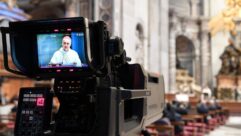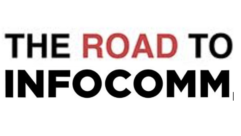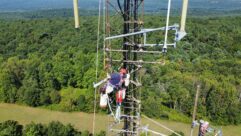Audio End-to-End for Worship
Apr 10, 2012 2:03 PM,
By Bruce Borgerson
Integrating Paradigm Shifts
Late last year, a paradigm shifted at the midsize mainline church in Oregon where I serve as volunteer technical director. Before the big change, our pastor was still preaching from a fixed pulpit, primarily because she likes to refer to a written text. Then came the Apple iPad. Now our pastor wanders about with her wireless lav, occasionally glancing down at the text on her iPad. Alas, whenever her head drops down, sound bounces off the iPad into the Sennheiser MKE 2 omni mic and causes a subtle yet perceptible change in her voice level and tonal balance. Oops. Time to retweak compression and budget for a headworn mic.
Granted, that’s a peculiar example, yet it illustrates an irreversible trend. Two paradigm shifts are underway, transforming the way AV integrators will design, configure, install, and troubleshoot audio systems for all but the very smallest and most traditional churches. These changes affect every part of the audio chain, from wireless microphones through loudspeakers and streaming media delivery. It’s an end-to-end proposition that requires rethinking how you approach your bid proposals, and what you must communicate to church committees and staff, who will come to the table with varying levels of technical sophistication.
Pair Of Paradigms
The first paradigm shift is the rapid emergence of what I call the “ubiquitous user interface,” or UUI. Apple’s iOS devices have become dominant in pro audio despite some inroads by Google’s Android. Wherever any level of digital control is accessible, these devices are hooking into it and taking over. The mixing console as we have known it may be fading into history.
Another endangered species is the analog snake. Multi-channel audio networking is moving to the forefront, slowed only by lack of standardization and a “wait until it gets even faster and cheaper” mentality.
So what follows is a whirlwind overview of church audio systems, end-to-end, highlighting issues that need to be raised in light of these changes. Expect a barrage of new questions from knowledgeable church staff members, and be prepared to raise them yourself if church folk seem clueless.
Up Front: Audio Sources
So far, the paradigm shifts have had only marginal direct impact on wired microphone selection and use in most church worship applications. Quality dynamic microphones like the ubiquitous Shure SM58 remain dominant for contemporary praise music, while modular condenser systems from Neumann and Audio-Technica take care of choirs and acoustic instruments. Miniature headworn condenser mics are replacing lavalieres for spoken word, as the modest investment pays off in better quality and easier feedback control. The move to a quiet stage, with drum isolation and in-ear monitoring, has made it less problematic to upgrade vocal and instrument mics to higher-quality condenser models, often with notable improvements in overall musical depth and transparency. All of these possibilities should be brought up in discovery sessions with your church clients.
Moving from wired to wireless microphone applications, we find the iOS revolution in full swing. New wireless apps like AKG’s free Wireless App 2.0 tap into nearly all programmable and monitoring functions, from frequency scanning and allocation to low battery alerts. Essentially, all the information and control that used to be only accessible at the wireless rack or plugged-in laptop is now available to anybody with an iPhone—and, of course, the proper password.
Snake To CAT
The paradigm shift in signal transmission touches every part of the audio signal chain between inputs at the stage box and the power amplifier, be it standalone or inside the loudspeaker. Thick bundles of multicore analog audio cable are giving way to thin, lightweight runs of network cable for carrying signal from stage to FOH mix and then out to drive racks, powered loudspeakers, multi-track recorders, and broadcast/streaming devices.
Every church must be made aware of this change and all the ramifications for further system upgrades in the future. Cost comparisons should be done in nearly every case. Some churches, being conservative by nature, may be wary and stick with analog for now, but if you’re installing new multicore analog lines, it would be foolhardy not to run redundant Cat-6A alongside to be ready for the inevitable. The primary sticking point now is, of course, the long menu of networking options and their mutual incompatibility. CobraNet, Dante, A-Net, REAC, EtherSound, and others all have relative advantages and drawbacks, and some churches are understandably reluctant to adopt different protocols to handle, for example, personal stage monitoring, stage to FOH, and console to power amplifiers. Roland Systems Group takes one tack by offering soup-to-nuts with its own REAC, while Yamaha plays the field by offering connectivity cards from several third-party providers. The emerging AVB standard promises some relief from the technobabble, but we’re not quite there yet.
Regardless, all these networks use the same cable, and every church audio infrastructure remodel should have it running—redundantly—everywhere audio needs to go. The smaller the church, the cheaper the cable runs, so no exceptions.
Audio End-to-End for Worship
Apr 10, 2012 2:03 PM,
By Bruce Borgerson
Integrating Paradigm Shifts
Mixing In The Middle
For larger and more technically sophisticated churches, any new construction or major remodel will almost certainly require some kind of networked audio infrastructure and at least one large-format digital mixing console. The big boards from Allen & Heath, Avid, DiGiCo, Midas, SoundCraft/Studer, and Yamaha provide the high channel counts, total programmability, and integrated effects that these churches require, and at prices that drift steadily downward. At this level, analog is out of the picture.
At the other end of the scale are smaller churches that are not looking to replace cabling infrastructure (yet) and have relatively homogenous worship production requirements, yet may still need a high channel count. In this case, though digital options should be on the table, analog will likely win out. Familiarity, reliability, and value still rule the day.
In the middle—accounting for perhaps 60 percent of U.S. congregations—are churches that could go either way. For these churches the determining factor will not be cost, but rather age of the congregation, technical sophistication of staff, and need for more advanced production capabilities.
For adventurous churches ready to ditch the snake, they now have an almost irresistible array of lower cost options from all the makers mentioned above. For only a modest premium beyond an analog system, they can access most of the same advantages as the megachurch high-end models. And yes, the newer consoles in this middle range, like the Midas Pro2C, come equipped with full iPad connectivity and dock.
Finally we have, in some of the most affordable consoles, the highest level of iOS integration. The StudioLive consoles from PreSonus pioneered the trend, and now offer control of virtually all parameters on an iPad plus a dedicated personal monitor feature set for iPhone and iPod. But they still have tactile faders and knobs for the mixer who “stays home” at FOH.
Mackie takes the next daring step with its DL1068, which is basically just an I/O box with preamp gain knobs. All other parameters are controlled on the iPad, which can stay in the home dock on the unit or roam on Wi-Fi.
This trend is irreversible, but I suspect it may cause more dubious churches in the middle to wait and see. Obviously there are new issues to address, most notably security. I don’t worry about our church’s 40-channel analog board leaving with a casual light-fingered visitor. But what if the keystone of your worship audio is contained inside a temporarily unattended iPad? Churches and integrators need to think through these questions before making the plunge.
The New Monitoring
Both paradigm shifts have hit full force in the world of stage monitoring. Stage wedges are slowly disappearing, and don’t expect to sell any more dedicated monitor consoles to churches. The personal monitoring revolution has arrived. Aviom launched the trend with its phenomenally popular line of knobs-on-box personal mixers, all linked with a proprietary network. Roland took a similar approach with its REAC-based system, and the two dominated the market until the iOS phenomenon hit. At least three makers—PreSonus, Mamba Mix, and Pivitec—now have systems that use iPads or iPod/iPhones for mixer control. In the case of PreSonus, it’s an essentially free add-on for controlling your designated auxiliary output; with the other two, your iOS device controls a dedicated, networked-connected output module.
Looking into the future from the integrator’s perspective, the primary concern here is once again the audio network infrastructure. Right now the connection to the main mixer is either analog or an interface card to a proprietary network. Down the road, will the monitor network of choice talk to the FOH console network of choice? Will all eventually knuckle under and adopt AVB, as two have done for internal networking? These questions need to be approached well in advance.
Saving The Service
System integrators have included basic, mono-stereo recording functions in most church audio systems for decades. Within the last two decades we’ve migrated from cassettes to CDs to solid-state recording devices. That part of the equation has stayed stable in recent years, with the only notable addition being the USB recording facilities now integrated into most $500+ consoles, digital and analog.
Multitrack recording has become increasingly common in churches, as it enables both virtual sound checks and audio post for archived webcasts. The hardware and infrastructure here is more complicated, primarily because the digital networking paradigm shift has opened new options and limited others. Some remaining mid-priced analog consoles have dedicated channel outputs for recording, but this option is slowly disappearing, primarily because the recording devices that can connect via analog are just about gone. More often than not, the digital output configurations of the main FOH console will dictate the recording options. Avid has leveraged its dominant position with Pro Tools to offer seamless integration with its Venue series of live consoles. Roland has its own REAC-based multi-track unit, though it offers a REAC-to-MADI bridge for connecting to other makers’ systems. Other third-party options are available using MADI, Dante, and EtherSound, while Midas employs the SuperMAC/HyperMAC protocols to record as many as 192 channels at 96kHz. At the lower end of the scale, connection to DAWs via FireWire (IEEE 1394) or USB2.0 is the norm.
So, once again, before specifying a digital console or networked signal transmission in any church, make sure you fully assess both current and future recording needs.
Console To Cones
Within recent memory, the signal chain between the console and the loudspeaker involved three physically discrete steps: drive processing (EQ, active crossovers, limiting, and delay when needed); power amplification; and loudspeakers. Now it’s mix-and-match, with the processes freely moved about and combined. And, once again, both the networking and user-interface revolutions are playing an ever-larger role.
Before any final decisions are made regarding networked connections between stage and FOH, the connectivity to equipment rooms, remote amplifiers, and powered loudspeakers must be considered as well. Is networked audio advantageous to the church in this scenario? Is it possible to use the same network protocols? If not, are the proper interfaces or bridges available and reliable?
These points may tip the balance in determining both the general configuration and specific equipment recommendations. Is the church better served using three discrete steps, with drive processing, power amplification, and loudspeakers all in separate cabinets? Or should the loudspeaker processing and power amplification be combined, as is done with the BSS/Crown I-Tech series or the Lake/Lab.gruppen PLM series? Is it preferable to have amps and processing separate but packaged as an inhouse proprietary system, as with most L-Acoustics and d&b audiotechnik systems? Or should you put the EQ and delay functions in a rack processor and put everything else inside the speaker cabinet, as pioneered by Meyer Sound and now followed by many others? The more sophisticated churches will understand the up- and down-sides of the various options. Most will not, so some education will be in order.
As for the “UUI” paradigm shift, it’s growing here as well. Crown led the pack with its Powered by Crown app, but others are following close behind. If your service techs or church personnel want quick, convenient monitoring and control at this level, take heed of what’s available and what’s coming.
From Church To The World
The final step is, of course, sending the church’s audio out to the world. Only a few big churches still broadcast on radio or TV, but everybody is streaming on the ‘net. Even if a particular church isn’t there yet, you should explain the advantages, the basic technology, and make provision for it. In most cases, the audio couples with the video before feeding into a streaming service or device. Once again, you need to make provisions for proper audio connections to the inhouse streaming server, dedicated codec, or external streaming service.
To Each Its App
The last branch hanging off the end of the signal chain is the assistive listening system (ALS), most of which still tap into the audio via analog. But if AVB ever gains universal adoption, expect these to hop on the network as well.
Regarding smartphone apps, I don’t know of any that actually control an ALS system, as there’s really nothing much to control. In fact, until researching ALS systems this article, I was prepared to assert that ALS has not yet been hit by the iOS paradigm shift. That’s not the case. Listen Technologies introduced its ADA Compliance Assistive Listening Calculator app last December. I had no idea, even though I ordered one of Listen’s new systems for our church only weeks later. Imagine that. That app could have saved me a couple phone calls. I have to stay on top of these, and you do, too.









